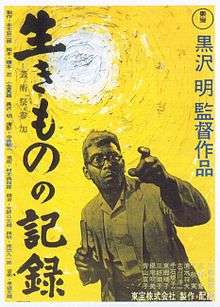I Live in Fear
| I Live in Fear | |
|---|---|
 | |
| Directed by | Akira Kurosawa |
| Produced by | Sōjirō Motoki |
| Written by |
Akira Kurosawa Shinobu Hashimoto Fumio Hayasaka Hideo Oguni |
| Starring |
Toshiro Mifune Takashi Shimura |
| Music by |
Masaru Sato Fumio Hayasaka |
Production company | |
| Distributed by | Toho Company Ltd. |
Release dates |
|
Running time | 103 minutes |
| Country | Japan |
| Language | Japanese |
I Live In Fear (生きものの記録 Ikimono no kiroku, aka Record of a Living Being or What the Birds Knew) is a 1955 Japanese film written and directed by Akira Kurosawa. It was co-written by Shinobu Hashimoto, Fumio Hayasaka, and Hideo Oguni. The story concerned an elderly factory owner (Toshiro Mifune) so terrified of the prospect of a nuclear attack that he becomes determined to move his entire extended family (both legal and extra-marital) to what he imagines is the safety of a farm in Brazil.
The film stars Kurosawa regulars Toshiro Mifune and Takashi Shimura. It is in black-and-white and runs 103 minutes. The film was entered into the 1956 Cannes Film Festival.[1]
Cast
- Toshiro Mifune as Kiichi Nakajima
- Takashi Shimura as Dr. Harada
- Minoru Chiaki as Jiro Nakajima
- Eiko Miyoshi as Toyo Nakajima
- Kyoko Aoyama as Sue Nakajima
- Haruko Togo as Yoki Nakajima
- Noriko Sengoku as Kimie Nakajima
- Akemi Negishi as Asako Kuribayashi
- Hiroshi Tachikawa as Ryoichi Sayama
- Kichijirō Ueda as Mr. Kuribayashi's father
- Eijirō Tōno as Old man from Brazil
- Yutaka Sada as Ichiro Nakajima
- Kamatari Fujiwara as Okamoto
- Ken Mitsuda as Judge Araki
- Masao Shimizu as Yamazaki, Yoshi's husband
Plot
Kiichi Nakajima (Toshiro Mifune), an elderly foundry owner convinced that Japan will be affected by an imminent nuclear war, resolves to move his family to safety in Brazil.[2] Nakajima's fervent wish is for his family to join him in escaping from Japan to the relative safety of South America. His family decides to have him ruled incompetent, and he is brought before a three-man tribunal, including Dr. Harada (Takashi Shimura), a Domestic Court counselor, for arbitration. Harada, a civil volunteer in the case, sympathizes with Nakajima's conviction. He points out that the fear of atomic and nuclear weapons is present in every citizen of Japan, and wonders aloud whether it is wrong to rule someone incompetent simply for being more worried than the average citizen. Eventually, the old man's irrational behavior prevents the court from taking his fears seriously, and he is found incompetent. Nakajima grows more and more obsessed with the idea of escaping Japan, eventually resulting in a tragic decision, once he is convinced it is the only way to save his loved ones. The film ends with the doctor pondering whether it may be more insane to ignore the nuclear threat than to take it too seriously.
Production
This was the last film that composer Fumio Hayasaka worked on before dying of tuberculosis in 1955. He had been Kurosawa's close friend since 1948 and had collaborated with him on several films.
References
- ↑ "Festival de Cannes: I Live in Fear". festival-cannes.com. Retrieved 2009-02-03.
- ↑ Kaplan, Fred (2008-01-29). "I Live in Fear: What Kurosawa's forgotten film about the bomb captures about post-9/11 America". Slate.
External links
- I Live in Fear at Rotten Tomatoes
- I Live in Fear at the Internet Movie Database
- I Live in Fear (Japanese) at the Japanese Movie Database
- I Live in Fear at AllMovie